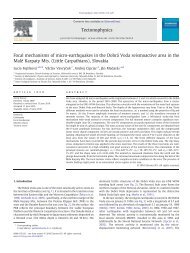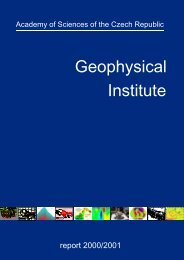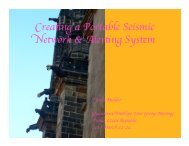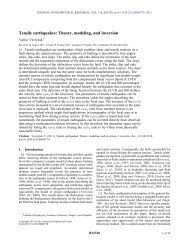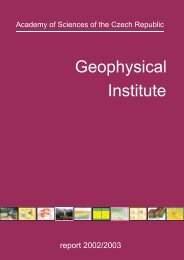Geophysical Institute of the ASCR
Geophysical Institute of the ASCR
Geophysical Institute of the ASCR
Create successful ePaper yourself
Turn your PDF publications into a flip-book with our unique Google optimized e-Paper software.
Let us try to answer <strong>the</strong> question what leads to <strong>the</strong> streng<strong>the</strong>ning <strong>of</strong> westerlies and to changes in <strong>the</strong><br />
distribution <strong>of</strong> main pressure formations, especially to <strong>the</strong> stronger Icelandic low and to its eastward<br />
shift at times <strong>of</strong> high geomagnetic activity. Due to processes in <strong>the</strong> magnetosphere during<br />
geomagnetic storms downward winds are generated in <strong>the</strong> polar <strong>the</strong>rmosphere. It is probable that<br />
geomagnetic activity affects <strong>the</strong> propagation <strong>of</strong> planetary waves by changing <strong>the</strong> temperature <strong>of</strong> <strong>the</strong><br />
lower <strong>the</strong>rmosphere but also by changing <strong>the</strong> ozone concentration in <strong>the</strong> stratosphere. We studied<br />
whe<strong>the</strong>r <strong>the</strong>re is an atmospheric response to geomagnetic activity and found that downward winds<br />
penetrate through <strong>the</strong> stratosphere to <strong>the</strong> troposphere and accelerate <strong>the</strong> subsidence <strong>of</strong> air especially in<br />
some regions along <strong>the</strong> nor<strong>the</strong>rn margin <strong>of</strong> <strong>the</strong> Siberian High and <strong>the</strong> west coast North American<br />
ridge. This process is connected with an increase <strong>of</strong> pressure and temperature, <strong>of</strong> <strong>the</strong> jet stream and <strong>of</strong><br />
westerlies (Bucha and Bucha, 1998). We show that enhanced geomagnetic activity participates in <strong>the</strong><br />
streng<strong>the</strong>ning <strong>of</strong> westerlies and in <strong>the</strong> eastward shift <strong>of</strong> main pressure formations (Icelandic Low,<br />
Azores and Canadian High) that influence NAO and inter-annual fluctuations <strong>of</strong> temperature in<br />
Europe and North America. As a result, <strong>the</strong> warm flow prevails in <strong>the</strong> region <strong>of</strong> Europe enhancing<br />
temperatures here while <strong>the</strong> cold flow from <strong>the</strong> northwest participates in below normal summer<br />
temperatures in <strong>the</strong> USA and in Asia. From <strong>the</strong> positive correlation between <strong>the</strong> temperature in <strong>the</strong><br />
USA and <strong>the</strong> global temperature (correlation coefficient equals 0.72) follows that geomagnetic<br />
activity has an influence not only on regional but also on global temperatures (Fig. 38, curves e, f).<br />
Because <strong>the</strong> summer temperature is for several regions (Europe) positively correlated and for o<strong>the</strong>r<br />
regions (<strong>the</strong> USA) negatively correlated with geomagnetic activity we can conclude that this external<br />
geomagnetic forcing on fluctuations <strong>of</strong> temperature is not direct but is realized through significant<br />
changes in <strong>the</strong> distribution <strong>of</strong> main pressure formations (Icelandic Low, Azores High, Canadian<br />
High). The shifts <strong>of</strong> <strong>the</strong>se systems <strong>the</strong>n participate in changes <strong>of</strong> wind directions and, as <strong>the</strong> next step,<br />
in temperature changes.<br />
Geomagnetic activity, as follows from a close association (Bucha, 2005), has an influence on interannual<br />
changes <strong>of</strong> pressure as well as <strong>of</strong> regional and global temperatures. The long-term gradual<br />
increase <strong>of</strong> average global temperature over <strong>the</strong> 20th century by about 0.6°C is obviously caused<br />
mainly by anthropogenic effects even though some part <strong>of</strong> <strong>the</strong>se changes can be a reflection <strong>of</strong> slowly<br />
increasing average geomagnetic activity.<br />
References<br />
Bucha V. and Bucha V., 1998. Geomagnetic forcing <strong>of</strong> changes in climate and in <strong>the</strong> atmospheric circulation. J. Atm. Solar<br />
Terr. Phys. 60, 145-169.<br />
Bucha V. and Bucha V., 2002. Geomagnetic forcing and climatic variations in Europe, North America and in <strong>the</strong> Pacific<br />
Ocean. Quaternary International, 91, 5-15.<br />
Bucha V., 2004. Geomagnetic activity and temperatures in Europe. Meteorological and <strong>Geophysical</strong> Fluid Dynamics.<br />
Wilfried Schroeder/Science Edition, Darmstadt, 278-283.<br />
Bucha V., 2005. Vliv geomagneticke aktivity na regionalni a globalni teploty (Geomagnetic forcing on regional and global<br />
temperatures). Meteorologické zprávy (Meteorological Bulletin), CHMI, 58, 5, 139-145.<br />
58




